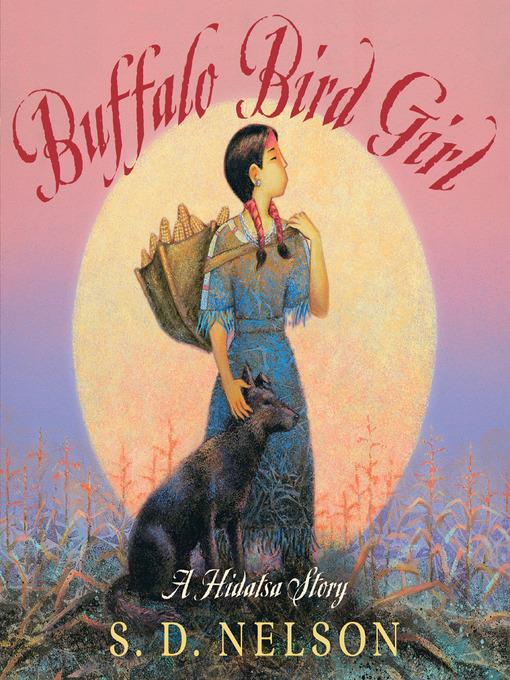
Buffalo Bird Girl
A Hidatsa Story
فرمت کتاب
ebook
تاریخ انتشار
2013
Lexile Score
890
Reading Level
4-5
ATOS
5.9
Interest Level
K-3(LG)
نویسنده
S. D. Nelsonناشر
ABRAMSشابک
9781613124871
کتاب های مرتبط
- اطلاعات
- نقد و بررسی
- دیدگاه کاربران
نقد و بررسی

December 24, 2012
Blending archival material with original prose and artwork, Nelson (Black Elk's Vision: A Lakota Story) crafts a first-person biography of Waheenee-wea (Buffalo Bird Woman), a member of the Hidatsa tribe that flourished near the Missouri River on the Great Plains. Photographs of the Hidatsa people tending to crops, preparing food, and dressed in traditional attire bring their daily activities and traditions into vivid relief. Nelson's acrylic paintings and b&w pencil drawings are intriguingly interlaced with the photographs, contrasting Native American figures in blunt profile with harvest colors and background textures that mimic dried spears of grass, leather skins, and basket weaves. Quotations from Buffalo Bird Woman's writings (which she recorded in collaboration with an anthropologist in 1906) appear throughout, including a lament over the loss of land and customs after her people were relocated to a reservation: "I am an old woman now. The buffaloes and black-tail deer are gone, and our Indian ways are almost gone. Sometimes I find it hard to believe that I ever lived them." A memorable account of perseverance. Ages 6â10.

Starred review from September 15, 2012
A noted Native American artist interprets the early life of Buffalo Bird Woman, Waheenee-wea, one of the last of the Hidatsa to live according to old traditions. Using material from his subject's own reminiscences, published by an anthropologist in the early 20th century, Lakota painter and biographer Nelson describes Buffalo Bird's village childhood. Each section begins with a quote from her own story. Born around 1840, "three years after the smallpox winter," the girl grew up in Like-a-Fishhook Village high over the Missouri River in what is now North Dakota. There, for nine months of each year, she lived with her family in an earth-mound lodge. She describes helping her aunts and grandmother with traditional household and garden tasks, visiting a trading center, playing with other children and her dog, and a Lakota attack. During winter's worst weather, villagers retreated to temporary lodges in the woodlands, where they ate stored food. The extraordinary illustration of this handsome volume begins with the endpaper maps and features acrylic paintings of the Hidatsa world reminiscent of traditional Plains Indian art. Pencil drawings and relevant, carefully labeled photographs round out the exquisite design. All the artwork both supports and adds to the text. An extensive author's note and timeline supplement this beautiful tribute. Pair with Nelson's Gift Horse (1999) for a broad vision of Plains Indian childhood. (notes, bibliography, index) (Informational picture book. 7-12)
COPYRIGHT(2012) Kirkus Reviews, ALL RIGHTS RESERVED.

Starred review from November 1, 2012
Gr 3-6-In 1921, anthropologist Gilbert L. Wilson published Waheenee: An Indian Girl's Story. In it, his narrator, Buffalo Bird Woman, recounted her experiences growing up on the Great Plains of North Dakota in the traditional Hidatsa culture of the late 19th century. In this lovely book, similar in verbal and illustrative caliber to his Black Elk's Vision: A Lakota Story (Abrams, 2010), Nelson takes Wilson's rendering of Buffalo Bird Woman's life and focuses on her childhood in the 1830s and 1840s. A meld of full-color, acrylic paintings, soft black colored-pencil drawings, and both period and contemporary photos re-creates the life of a child on the open prairie. The Hidatsa awareness of the passing seasons, the chores, farming tasks, and hunting practices of the tribe are aligned with the annual rhythm in a prose that is at once informative and rhythmic. Historical events are related, such as the advent of the fur-trading business with its concomitant influx of white traders, the construction of Fort Berthold, wars with the Lakota, and the decimating smallpox epidemic that struck when Buffalo Bird Woman was six, carrying off her mother, brother, and one of her aunts. The tone is at once matter of fact and elegiac, as Buffalo Bird Woman finishes her narrative as an old woman, living on the Fort Berthold Indian Reservation in North Dakota. A beautiful introduction to a traditional way of life, the book contains a detailed historical afterword and a rich array of back matter. This is a lovely and graceful introduction to a way of life that persists despite cultural obstacles and the march of time.Ann Welton, Grant Elementary School, Tacoma, WA
Copyright 2012 School Library Journal, LLC Used with permission.

























دیدگاه کاربران